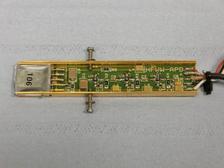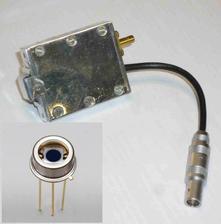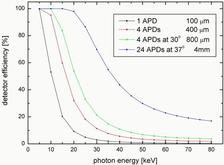Excelitas 10mm x 10mm APD in flat housing
To collect the forward and/or inelastic scattered intensity detectors based on fast Avalanche Photo Diodes (APDs) are chosen.
Three APD types were selected as standard for different applications.
- For NIS applications Excelitas 10mm x 10mm silicon APDs of 100 microns thickness are chosen in order to provide a large solid angle for detection of the fluorescence signal.
Two different detector designs incl. the amplifier circuit are shown on the right.
The stacked APDs are connected to and powered by the ACE module, which provides the baseline-restoring.
- For NFS applications the standard APD is an Excelitas silicon APD with an active area of 5 mm x 5 mm and a thickness of about 100 microns (time resolution 1 ns).
To achieve good detector efficiency stacks of up to 4 single 5mm x 5mm APDs are used. For energies above about 20 keV the APDs can be inclined in order to further increase the efficiency.
The APD stack is mounted on a xy-linear stage, for experiments in theta-2theta geometry a Kohzu tilt stage provides the corresponding inclination of the APD stack.
For high energy applications (above 30 keV) and short lifetimes (below 5 ns) a recently developed stack of 16 thin Hamamatsu S5344 APDs (3 mm diameter, thickness 30 microns) is used delivering an overall time resolution of about 0.6 ns (250 ps time resolution of a single element). This 16 element detector was essential for successful NFS experiments at following resonances:
125Te, E = 35.5keV,  = 2.1ns
= 2.1ns
121Sb, E = 37.1kev,  = 5ns
= 5ns
193Ir, E = 73.0keV,  = 8.8ns
= 8.8ns
A single detector element and a single APD (Hamamatsu S5344) are displayed in the mext figure on the right.
All APDs offer single photon counting with time resolution from 0.3ns to 1ns and a dynamic range of about 0-200MHz.
Faster detectors and data processing schemes are under development.
The detector efficiency as a function of x-ray energy for APD detectors of different thicknesses is shown in the graph on the right.








